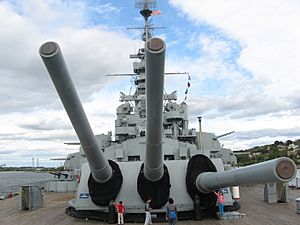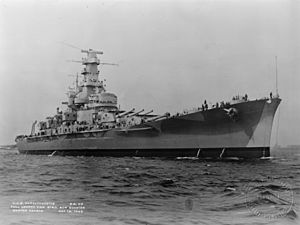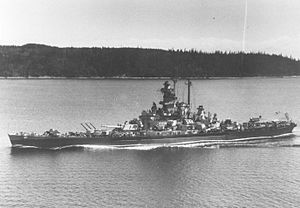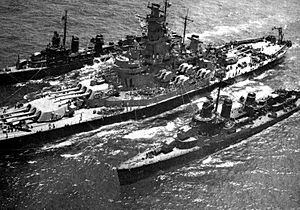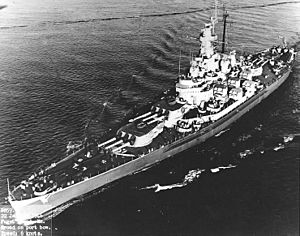USS Massachusetts (BB-59) facts for kids
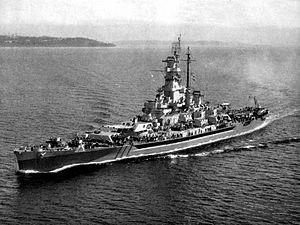
Massachusetts off the coast of Point Wilson, Washington, c. July 1944
|
|
| History | |
|---|---|
| Name | Massachusetts |
| Namesake | Massachusetts |
| Builder | Bethlehem Steel Corporation (Fore River Shipyard) |
| Laid down | 20 July 1939 |
| Launched | 23 September 1941 |
| Commissioned | 12 May 1942 |
| Decommissioned | 27 March 1947 |
| Stricken | 1 June 1962 |
| Status | Museum ship at Battleship Cove since 14 August 1965 |
| General characteristics | |
| Class and type | South Dakota-class battleship |
| Displacement | |
| Length | 680 ft (210 m) o/a |
| Beam | 108 ft 2 in (32.97 m) |
| Draft | 35 ft 1 in (10.69 m) |
| Installed power |
|
| Propulsion | |
| Speed | 27.5 knots (50.9 km/h; 31.6 mph) |
| Range | 15,000 nmi (28,000 km; 17,000 mi) at 15 knots (28 km/h; 17 mph) |
| Crew |
|
| Armament |
|
| Armor |
|
| Aircraft carried | 3 × "Kingfisher" floatplanes |
| Aviation facilities | 2 × catapults |
The USS Massachusetts (BB-59) is a famous battleship that served in the United States Navy. It was one of four powerful ships in the South Dakota class. These battleships were designed in the late 1930s, just before World War II.
Massachusetts was built to be very strong. It had large 16-inch guns and thick armor. This made it a formidable warship. However, rules about ship size meant it was a bit cramped inside. During the war, more anti-aircraft guns were added, and the crew grew larger.
The ship played a big role in World War II. It helped invade North Africa in 1942. There, it fought against a French battleship called Jean Bart. After that, Massachusetts moved to the Pacific Ocean. It helped protect aircraft carriers from enemy planes and ships.
It took part in many important battles. These included campaigns in the Gilbert and Marshall Islands and the Philippines. Later, it supported the Battle of Okinawa and attacked factories in Japan.
After the war, Massachusetts was taken out of service in 1947. It stayed in reserve until 1962. Then, in 1965, it became a museum ship. Today, you can visit it at Battleship Cove in Fall River, Massachusetts. It's a great way to see a real battleship up close!
Contents
Building and Features of the Massachusetts
The South Dakota-class battleships were built when countries were starting to build bigger warships again. Before this, international agreements limited the size and weapons of battleships. But these rules began to change.
How the Massachusetts Was Designed
The US Navy wanted to build ships with powerful 16-inch guns. They also wanted strong armor. But they had to keep the ship's total weight as low as possible. This was a challenge for the designers.
The Massachusetts is about 680 feet long. That's longer than two football fields! It is 108 feet wide. The ship could travel at a top speed of 27.5 knots (about 31 miles per hour). It had a long cruising range, meaning it could travel far without needing to refuel.
The ship had a crew of about 1,793 people in peacetime. During the war, this number grew to 2,500. It also carried three small floatplanes. These planes were used for scouting and spotting targets. They launched from catapults on the back of the ship.
Powerful Weapons of the Battleship
The main weapons were nine 16-inch guns. These were in three large turrets. Two turrets were at the front, and one was at the back. These guns could fire shells weighing over a ton!
For smaller targets and air defense, it had twenty 5-inch guns. These guns could shoot at both ships and planes. When it was first built, it also had many smaller anti-aircraft guns. These included 40 mm Bofors guns and 20 mm Oerlikon cannons. These guns were crucial for shooting down enemy aircraft.
Strong Armor for Protection
The Massachusetts was built with very thick armor. Its main armored belt was 12.2 inches thick. The main deck armor was up to 6 inches thick. The gun turrets had 18-inch thick armor on their faces. This heavy armor helped protect the ship from enemy shells.
Upgrades and Changes During the War
Throughout its time in service, Massachusetts received many upgrades. Most of these changes improved its ability to detect enemies and defend against air attacks.
Radar and Electronics
Early on, the ship got SC air search radar. This helped it find enemy planes. Later, it received SK and SG radars for better detection. It also had special radars (Mark 8 and Mark 4) to help aim its main and secondary guns. These radars were very important for fighting at night or in bad weather.
More Anti-Aircraft Guns
The number of anti-aircraft guns on Massachusetts grew a lot during the war. More 40 mm quad mounts were added. The number of 20 mm guns also increased significantly. By 1943, it had 61 of these smaller guns. These additions made the ship much better at defending itself from air raids.
However, the Navy later realized that 20 mm guns were less effective against newer planes. So, they planned to reduce their number and add even more 40 mm guns. By the end of the war, Massachusetts had 72 barrels of 40 mm guns.
Battleship Massachusetts in Action
The Massachusetts had an exciting career, taking part in major battles in both the Atlantic and Pacific Oceans.
Building and First Missions
Massachusetts was built in Quincy, Massachusetts. It was launched in 1941 and officially joined the Navy in May 1942. After training, it was sent to support Operation Torch. This was the Allied invasion of French North Africa in November 1942.

During the Naval Battle of Casablanca, Massachusetts faced French defenses. These included coastal guns and the battleship Jean Bart. Massachusetts fired its big guns at Jean Bart, hitting it five times. These hits disabled Jean Bart's main guns. The American ships also destroyed other French defenses and ships in the harbor. After this success, Massachusetts headed to the Pacific Ocean.
Fighting in the Pacific War
Massachusetts arrived in the Pacific in March 1943. It spent several months escorting convoys to the Solomon Islands. It also helped cover an invasion of New Georgia.
Battles in the Gilbert and Marshall Islands
In November 1943, Massachusetts joined the Gilbert and Marshall Islands campaign. It escorted aircraft carriers that attacked Japanese islands like Makin, Tarawa, and Abemama. These attacks helped prepare for land invasions. On December 8, it bombarded Japanese positions on Nauru.
In January 1944, the ship took part in the Battle of Kwajalein. It bombarded the island before marines landed. For much of the Pacific War, Massachusetts protected aircraft carriers. Its anti-aircraft guns were vital against Japanese air attacks.
It also participated in Operation Hailstone in February 1944. This was a big carrier raid on Chuuk Lagoon, a major Japanese base. The fleet then attacked islands like Saipan and Guam. Massachusetts helped defend against Japanese air attacks during these operations.
After many battles, the ship needed repairs. Its guns were worn out from firing so much. So, Massachusetts went to a shipyard for an overhaul. It rejoined the fleet in August 1944.
The Philippines Campaign
In October 1944, Massachusetts helped prepare for the invasion of the Philippines. It escorted carriers that attacked Japanese airfields on Okinawa and Formosa. These attacks aimed to weaken Japan's ability to fight back.
The landing on Leyte in the Philippines led to a huge naval battle. This was the Battle of Leyte Gulf. The Japanese navy tried a complex plan to attack the American invasion fleet. Massachusetts was part of a group of fast battleships. They were ready to fight Japanese ships.
During the battle, American carriers attacked the Japanese Northern Force. Massachusetts was with these carriers. Later, another Japanese force tried to attack the invasion fleet directly. Massachusetts and other battleships were sent to stop them. However, they arrived too late, as the Japanese force had already retreated.
In December, Massachusetts was caught in Typhoon Cobra. The storm caused damage to the fleet, but Massachusetts was not seriously harmed. It lost two of its scouting planes.
Final Attacks on Japan
By February 1945, Massachusetts was supporting the Battle of Iwo Jima. It escorted carriers that attacked targets on Honshu, Japan. These attacks helped prepare for the invasion of Iwo Jima.
In March, the ship helped prepare for the Battle of Okinawa. It shelled Okinawa and defended against intense Japanese air attacks. Many ships were hit by kamikaze planes, but Massachusetts was lucky and avoided being hit.
In July, Massachusetts was part of a group that bombarded industrial targets in Japan. This included steel factories in Kamaishi. This was the first time the Japanese mainland was attacked by battleships. It repeated these bombardments several times.
After Japan surrendered in August 1945, Massachusetts sailed back to the United States. It underwent repairs and then was decommissioned in 1947. It was placed in the reserve fleet.
There were ideas to modernize Massachusetts with new weapons like guided missiles. But these plans were too expensive. The ship remained out of service. In 1962, it was removed from the Navy's list of active ships.
A Museum Ship for Everyone
After being removed from service, a group of former crew members wanted to save Massachusetts. They worked hard to preserve it as a museum.
|
USS Massachusetts (BB-59)
|
|

Massachusetts at Battleship Cove
|
|
| Location | 5 Water Street, Battleship Cove, Fall River, Massachusetts |
|---|---|
| Built | 1941 |
| Architect | US Navy |
| NRHP reference No. | 76002269 |
| Significant dates | |
| Added to NRHP | 30 September 1976 |
| Designated NHL | 14 January 1986 |
Saving the Big Mamie
The Massachusetts Memorial Committee raised enough money to buy the ship. Children in the state even helped by donating money! On June 8, 1965, the Navy gave ownership of the ship to the state.
Two months later, on August 14, it arrived at Battleship Cove in Fall River, Massachusetts. Today, it's a popular museum. You can also see other ships there, like the destroyer Joseph P. Kennedy Jr. and the submarine Lionfish.
Repairs and Legacy
In the 1980s, some parts were taken from Massachusetts. These parts were used to help reactivate other battleships, the Iowa-class ships. But other than those parts and its aircraft catapults, Massachusetts still looks much like it did during World War II.
In 1998, Massachusetts went to Boston for major repairs. Workers added new steel to its hull to protect it from corrosion. They also fixed leaks and repaired its propellers. After four months of work, it returned to Battleship Cove in March 1999. Many people came to welcome it back.
Massachusetts is now a National Historic Landmark. It helps people learn about naval history and the brave sailors who served on it.
See also
 In Spanish: USS Massachusetts (BB-59) para niños
In Spanish: USS Massachusetts (BB-59) para niños
- List of museum ships
- List of National Historic Landmarks in Massachusetts
- National Register of Historic Places listings in Fall River, Massachusetts
- U.S. Navy museums (and other battleship museums)
- USS Salem (CA-139), a museum ship built in and today preserved in Quincy, Massachusetts, the world's only remaining heavy cruiser-class warship



